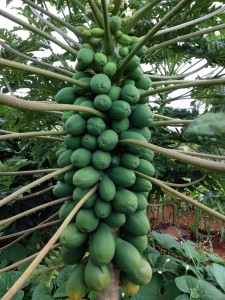Papaya Production, Part II
Community Contributed
By Glenn I. Teves, County Extension Agent, UH CTAHR
A major problem growing papaya on Molokai is Powdery Mildew, fungus that looks like white powder on leaves and fruits. It germinates in 10 to 12 hours under ideal conditions of low light, high humidity, and temperature ranges of 64 to 90 degrees F, sending roots or haustoria into the leaf or fruit to feed on plant cells and juices, causing early death and leaf drop. Without adequate leaves, papaya plants will not be able to convert enough sunlight into energy then to food, called photosynthesis. Without adequate food, plants will not produce enough sugars which give papaya the taste we’ve come to enjoy.

Papaya tree grown by Marshall Joy. It’s growing in compost and is an excellent example of a healthy and productive papaya tree.
At least seven species of mites attack leaves, fruits, and trunk, and they favor hot dry conditions. Luckily, the controls for mites and Powdery Mildew are the same. Wetable sulfur, including organic forms of this finely pulverized powder, reacts with air and water to form low doses of sulfuric acid that burn mites and powdery mildew. Adequate coverage is critical when spraying, and caution must be exercised because sulfur can irritate wet skin.
Root-knot nematodes are also a major problem. When papaya is planted in new fields, nematodes will multiply quickly and attack roots, creating galls that restrict uptake of nutrients and water. The use of cover crops, such as Sunn Hemp, before and after planting, will break the nematode cycle and allow a papaya field to be planted at very low nematode levels. Farm basics such as growing healthy seedlings and plants are important strategies so roots can grow quickly to outrace the nematodes. Another strategy is using compost in planting holes or incorporated into soil. The availability of adequate phosphorus throughout the root zone also plays an important role in root development.
Papaya Ringspot Virus (PRV) is by far the biggest threat to papaya production worldwide and almost destroyed the $30 million Hawaii papaya industry. Spread by aphids, PRV can move quickly to infect large areas of the state. This has happened in Waimanalo during the 1970s, and more recently in Puna on Hawaii Island. To address the problem, a research team led Hawaii-born Cornell University professor Dennis Gonsalves and researchers from UH CTAHR and the Hawaii Agriculture Research Center developed a disease-resistant cultivar called Sun Up through genetic modification (GM).
A protein coat from the Papaya Ringspot virus was inserted into a papaya, rendering it resistant to the virus. Named “Sun Up,” three additional GM papayas were developed through conventional crossing, including Rainbow and two others. Public acceptance has been mixed due to fears regarding genetically modified crops, and only through trade pressure from the U.S. was this papaya recently allowed into Japan. GM crops cannot be sold as organic.
PRV is rampant in the tropical world, but through the vigilance of residents and farmers, this disease is not present on Molokai so we’re able to grow papaya organically for a growing mainland market.
Wind protection is essential because papaya trees grow very tall. Ironwood, panax, dwarf brassaia, and others are effective in minimizing wind damage. Wind can affect all part of the tree including flowers, fruits, leaves, and roots leading to both low fruit productivity and quality.
All the papaya sold in Molokai stores are grown on Molokai, a testament to the hard working Molokai papaya growers. A publication of Powdery Mildew of Papaya can be downloaded from the UH CTAHR website ctahr.hawaii.edu/oc/freepubs/pdf/PD-90.pdf.











Don't have a Molokai Dispatch ID?
Sign up is easy. Sign up now
You must login to post a comment.
Lost Password